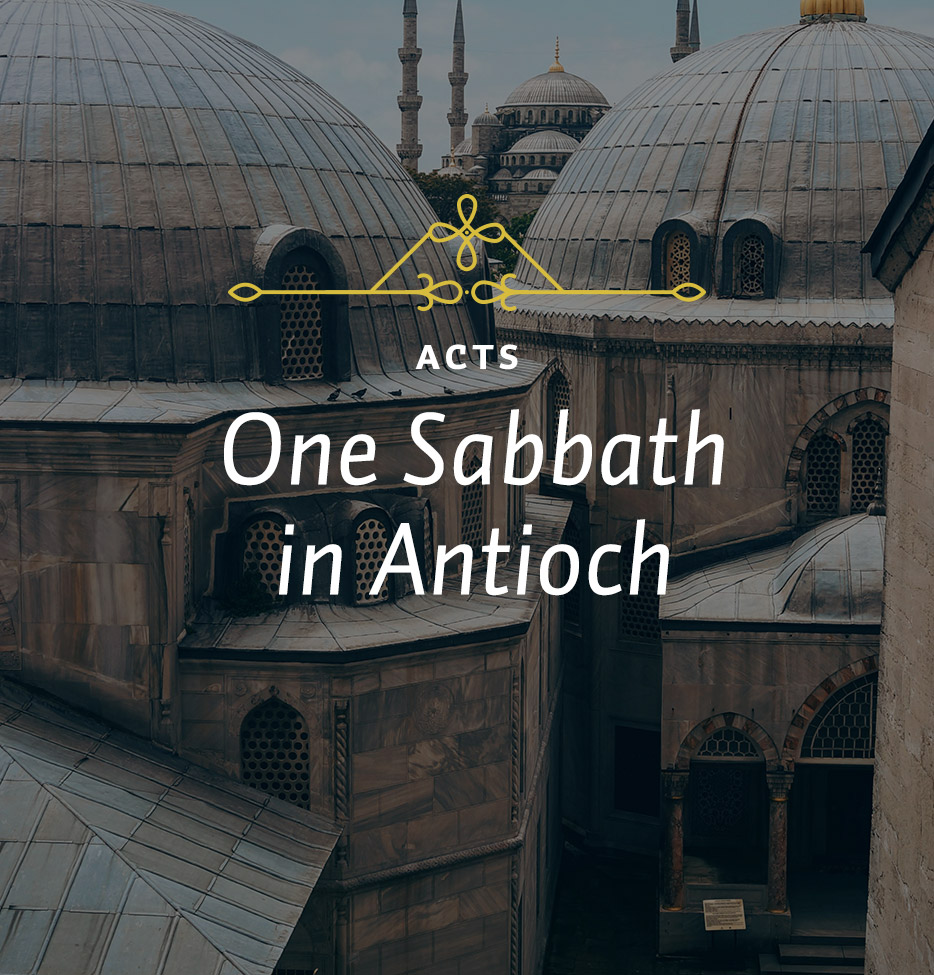Paul’s sermon has an introduction, four main points, and a conclusion. All good sermons have an introduction—some long, some short. This sermon has a brief introduction. It might be the case that Paul actually gave a much longer speech with a longer introduction and that Luke is merely summarizing here. But we have the drift of it.
Paul addresses two categories of people who were in the synagogue that day, and he calls for their attention: “Men of Israel and you Gentiles who worship God, listen to me” (v. 16). This indicates that there was a mixed worshiping community in this synagogue. There were Jews, of course. But there were also some devout Gentiles called “God-fearers” that is, Gentiles who worshiped the Jewish God but who had not yet become Jews by the formal rite of circumcision. By going to a synagogue like this Paul had an opportunity to preach to Jews, which he felt an obligation to do, but at the same time also to make contact with those Gentiles who had sensitivity to spiritual things. These would already have been instructed out of the Old Testament and would therefore be fertile ground for his evangelizing.
Once past the introduction, Paul organized his sermon into four parts: 1) a review of the Old Testament kerygma; 2) a statement of the New Testament kerygma; 3) a selection of supportive biblical texts; and 4) an announcement of the Gospel. The conclusion that follows this presentation is a warning of judgment to come if the Good News is not heeded. We need to look at each of these parts carefully.
1. The Old Testament kerygma. We looked at the word “kerygma” in an earlier study, noting that it is a Greek word meaning “proclamation.” It was introduced to biblical studies by C. H. Dodd, who used it to refer to the proclamation of specific facts concerning the death, burial, and resurrection of Jesus Christ.1 It has been used by biblical scholars since in a slightly broader way to refer to the way specific saving acts of God were recorded in both the Old and New Testaments. For example, G. Ernest Wright applied Dodd’s work to the Old Testament, pointing out that we find specific proclamation-outlines not only in New Testament sermons like this one by Paul or the earlier one by Stephen, which refer to the Old Testament, but even in the Old Testament itself—in some of the psalms, for instance. In each of these places a certain standard listing of the saving acts of God for His people is brought forward for the people’s remembrance.2
Paul does this briefly here, though we probably have a sharp condensing of his sermon by Luke. Because Paul is brief, we have to look carefully to appreciate the events of Israel’s history that he had in mind.
Verse 17: “The God of the people of Israel chose our fathers.” This is a reference to the patriarchal period, as Jews (as well as the instructed Gentiles present) would understand.
They would know that Paul was referring to God’s choice of Abraham, Isaac, and Jacob, the fathers of the people.
Verse 17: “…and made the people prosper during their stay in Egypt.” This is the period when Israel began to grow into a great nation. “With mighty power he led them out of that country.” This refers to the exodus.
Verse 18: “…and endured their conduct forty years in the desert.” This concerns the years of the wilderness wandering, during which Moses led them to the promised land.
Verse 19: “He overthrew seven nations in Canaan and gave their land to his people as their inheritance.” Here we have the conquest, as recorded in Joshua.
Verse 20: “After this, God gave them judges until the time of Samuel the prophet.” This sentence embraces the books of Joshua and 1 and 2 Samuel.
Verses 21-22: “Then the people asked for a king, and he gave them Saul son of Kish, of the tribe of Benjamin, who ruled forty years. After removing Saul, he made David their king. He testified concerning him: ‘I have found David son of Jesse a man after my own heart; he will do everything I want him to.’” These verses describe the first eighty years of the monarchy. G. Ernest Wright and others think the Old Testament kerygma ends at this point, coming to a climax in King David. After this the history of the people goes downhill.
The kerygma tells us that the Jewish view of history was really the Jewish view of God. People have asked whether the Old Testament is a book of theology or a book of history. The answer is that, in a sense, it is a book of theology, just as the New Testament is also a book of theology. But what is most important is that the Bible is a book about God’s saving acts, which is where the Bible’s theology is seen. We see this reflected in Paul’s words, for one of the things we notice is that he used the words “God” or “He” (referring to God) repeatedly: God did this, and God did that. It is always a case of God calling, moving, saving, delivering. This is wonderful theology. Even more, it is a theological worldview.
1C. H. Dodd, The Apostolic Preaching and Its Developments (New York: Harper & Brothers, 1935).
2G. Ernest Wright, God Who Acts: Biblical Theology as Recital, number 8 in the series “Studies in Biblical Theology” (London: SCM, 1952).






